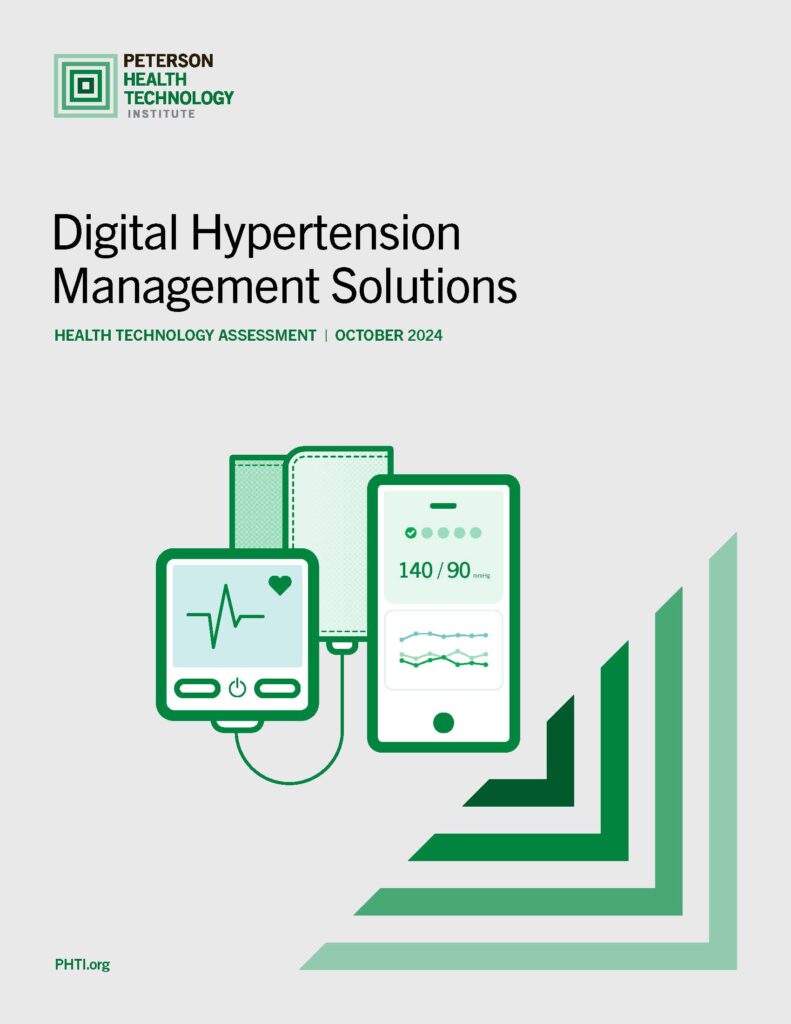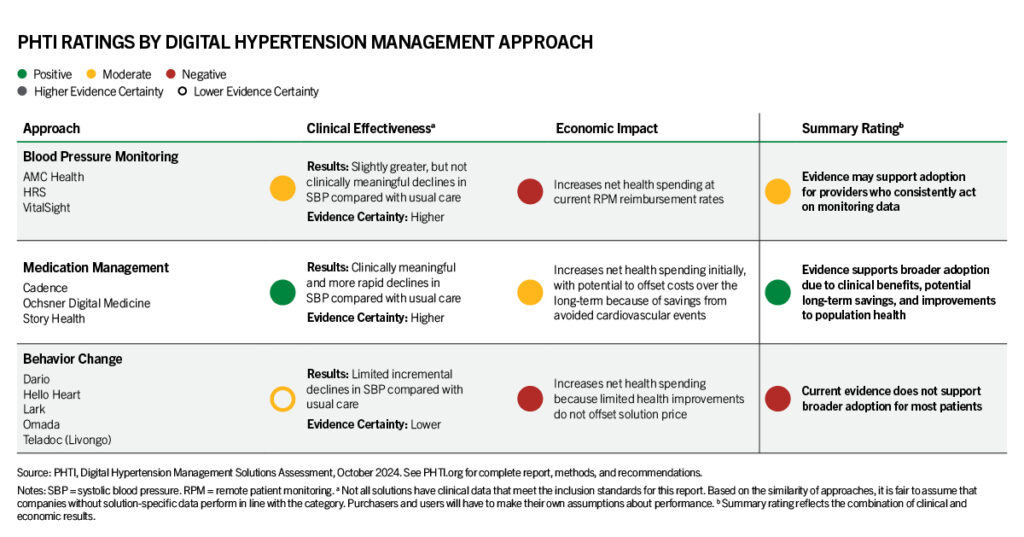completed Assessment
Digital Hypertension Management Solutions
Assessment Released
Last Updated
November 26, 2024
Conditions
Hypertension
"*" indicates required fields
PHTI assessed digital hypertension management solutions that aim to improve patients’ self-management and expand access to timely, effective treatment.
Area overview
Hypertension, also known as high blood pressure, is one of the most common chronic conditions in the United States, affecting an estimated 120 million adults and growing. It is also a contributing risk factor for potentially fatal diseases, such as heart disease, stroke, and chronic kidney disease. Hypertension affects all demographic groups, with a higher prevalence among Black people, men, and older adults.
Digital hypertension solutions aim to improve patients’ self-management and expand access to timely, effective treatment. These solutions are centered around a connected blood pressure cuff that delivers frequent and reliable home readings.
These solutions use three broad approaches:
- Blood Pressure Monitoring— Extend existing hypertension care beyond the clinical office by supporting patients’ home monitoring and delivering data back to the healthcare provider.
- Medication Management— Employ dedicated, virtual care teams to coordinate patients’ medication adjustments as a supplement to the patient’s main primary care team.
- Behavior Change solutions— Deliver educational content, alerts, reminders, and virtual interactions with coaches (digital or human) or care teams to improve patient’s self-management of their hypertension.
Download the evaluation

Digital Hypertension Management Solutions
Updated November 26, 2024
October 28, 2024
Executive SummaryOctober 28, 2024
Providers’ GuideOctober 28, 2024
Patient GuideOctober 28, 2024
Overview for PolicymakersOctober 28, 2024
AppendicesOctober 28, 2024
Data SupplementReport contributors and reviewers provided important expertise and insight throughout our process. Those who directly contributed to the report have no relevant conflicts of interest to disclose.
Summary of findings
PHTI’s independent evaluation found that digital hypertension solutions focused on medication management deliver rapid and clinically meaningful improvements in blood pressure that outperform usual care. Other digital approaches to hypertension management are less effective and do not provide clinically meaningful improvements, including solutions that transmit home monitoring data to providers, and solutions that focus on patient behavior change.
In terms of healthcare costs, all digital hypertension solutions increase spending in the short-term compared to usual care. However, solutions that focus on medication management are expected to produce long-term net savings from improved cardiovascular health that reduces the risk of stroke, heart attack, and death. These long-term clinical benefits have the potential, over a decade, to offset up front spending in the initial, three-year window.
The report supports broader adoption of digital hypertension solutions that focus on medication management by combining connected blood pressure cuffs with virtual care teams that help manage prescribing and dosing.

Webinar
Guidance & considerations for stakeholders
- Study the effects of combining blood pressure monitoring, goal-driven medication management, and behavior change for improved clinical outcomes and to close access and equity gaps for underserved patient populations.
- Increasingly integrate digital medication management into usual care and into other digital hypertension management solution types.
- Study the long-term impact of digital hypertension management solutions on clinical outcomes and healthcare utilization.
- Encourage greater investment in hypertension management by building short- and long-term budgets in the context of relevant quality improvement programs, such as Medicare Advantage Star Ratings or value-based payment arrangements.
Why assess digital hypertension management solutions?
- Nearly half of American adults have hypertension which progressively damages the cardiovascular and related systems. Despite its asymptomatic nature, the risks of uncontrolled hypertension—including heart disease, stroke, and kidney failure—are severe and well-documented.
- Black Americans have a higher incidence of hypertension than any other group, and Hispanic Americans have the fastest rates of growth in incidence.
- Effective management of hypertension not only enhances individual health outcomes, particularly among groups that already experience barriers to care, but also holds the potential to significantly reduce national healthcare spending.
- The number of adults achieving blood pressure control (BPC) in the United States has not kept up with the rising hypertension prevalence, as BPC rates have declined since 2014.
- Digital hypertension management solutions aim to address the clinical challenges of hypertension by engaging patients in their blood pressure treatment, improving their self-management, and expanding access to timely and appropriate care.
- A range of digital hypertension solutions have come to market, and purchasers—including health plans, employers, and providers—have widely adopted them.
- Embracing digital innovation for hypertension management could be essential for advancing hypertension care and achieving significant public health improvements. By enhancing awareness, refining treatment, and improving control, these technologies offer a promising path to better health outcomes and reducing healthcare costs.
- Given the widespread hypertension in the U.S. and impact on the healthcare system, payers, providers and patients are eager to understand which digital hypertension solutions provide meaningful results to patients at a lower cost. A range of digital hypertension solutions have come to market, and purchasers—including health plans, employers, and providers—have widely adopted them. In this context, digital hypertension management solutions have an important role to play in helping patients lower their blood pressure and improve their long-term cardiovascular health. This outcome depends on improving the clinical impact of digital tools by integrating the best components of existing solutions and aligning payment models with the long-term financial benefits of improved hypertension management.
Additional resources
April 2024
Methodology for a Systematic Literature Review of digital health technologies for hypertensionInternational prospective register of system reviews (PROSPERO), National Institute for Health and Care Research
Contact
Get in touch with us if you want to learn more about opportunities to provide input on this assessment.
"*" indicates required fields
Read an overview of our assessment Approach and Framework
View assessment frameworkRelated news
-
Read ArticleOct 31, 2024News Coverage
MedCity News
Digital Hypertension Solutions Are Everywhere, But Which Truly Improve Outcomes and Lower Costs?
-
Read ArticleOct 28, 2024News Coverage
Fierce Healthcare
Remote monitoring for hypertension has little value without medication management: PHTI
-
Read ArticleOct 28, 2024News Coverage
Modern Healthcare
Many digital hypertension tools are costly, not effective: study
Stay up to date
Sign up to receive updates.